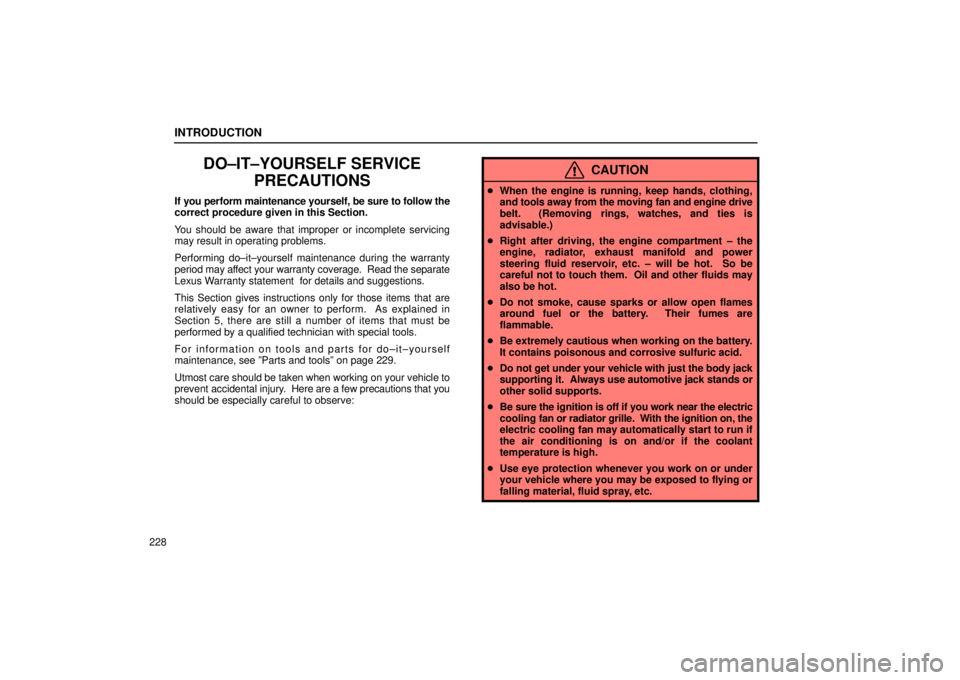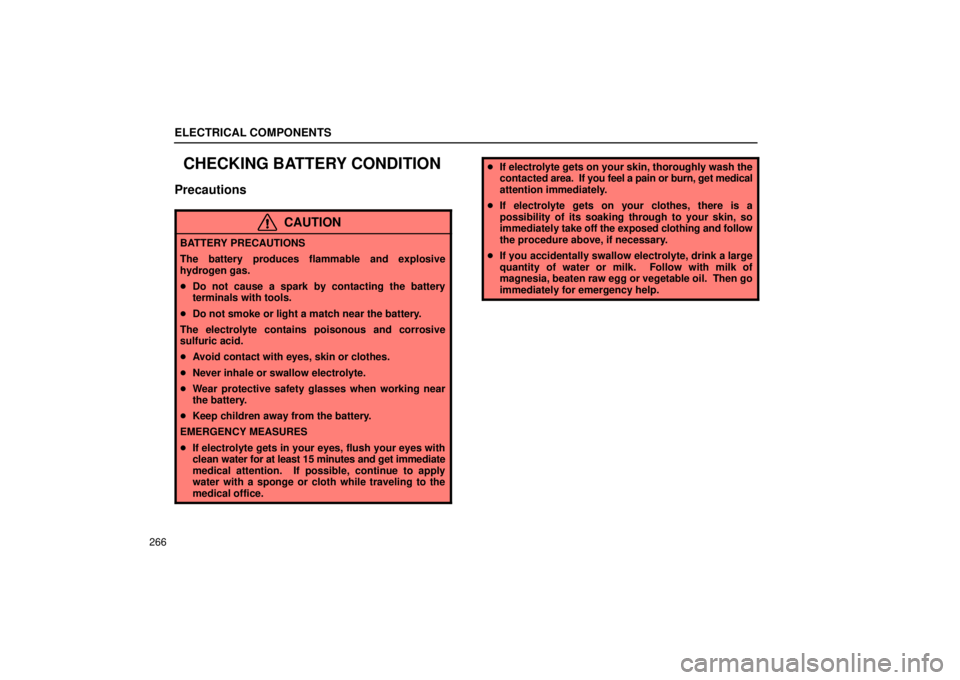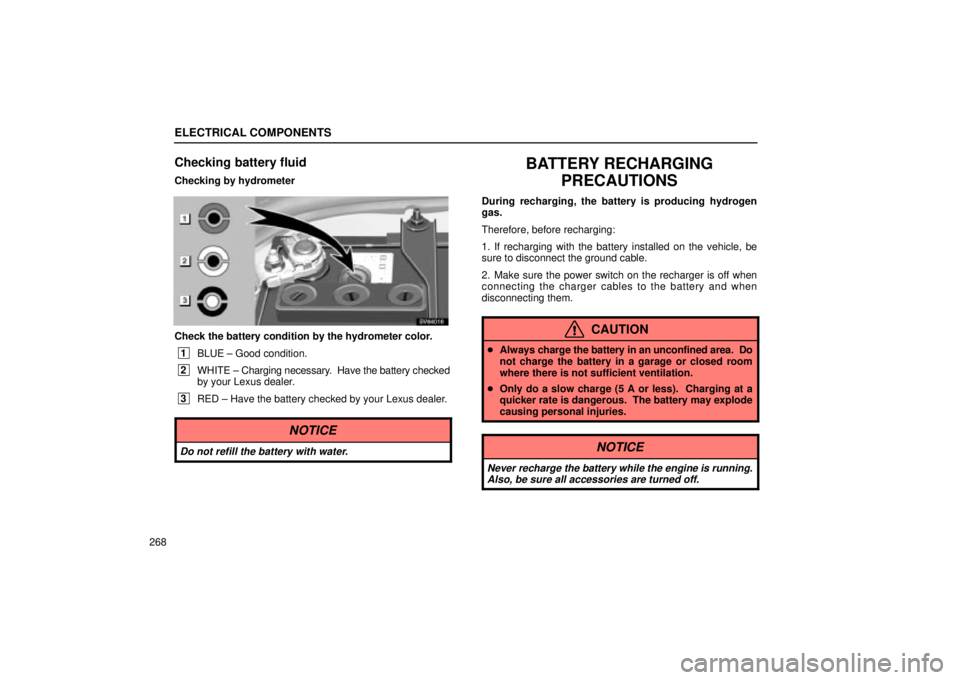Page 240 of 301

INTRODUCTION
228
DO±IT±YOURSELF SERVICEPRECAUTIONS
If you perform maintenance yourself, be sure to follow the
correct procedure given in this Section.
You should be aware that improper or incomplete servicing
may result in operating problems.
Performing do±it±yourself maintenance during the warranty
period may affect your warranty coverage. Read the separate
Lexus Warranty statement for details and suggestions.
This Section gives instructions only for those items that are
relatively easy for an owner to perform. As explained in
Section 5, there are still a number of items that must be
performed by a qualified technician with special tools.
For information on tools and parts for do±it±yourself
maintenance, see ºParts and toolsº on page 229.
Utmost care should be taken when working on your vehicle to
prevent accidental injury. Here are a few precautions that you
should be especially careful to observe:
CAUTION
� When the engine is running, keep hands, clothing,
and tools away from the moving fan and engine drive
belt. (Removing rings, watches, and ties is
advisable.)
� Right after driving, the engine compartment ± the
engine, radiator, exhaust manifold and power
steering fluid reservoir, etc. ± will be hot. So be
careful not to touch them. Oil and other fluids may
also be hot.
� Do not smoke, cause sparks or allow open flames
around fuel or the battery. Their fumes are
flammable.
� Be extremely cautious when working on the battery.
It contains poisonous and corrosive sulfuric acid.
� Do not get under your vehicle with just the body jack
supporting it. Always use automotive jack stands or
other solid supports.
� Be sure the ignition is off if you work near the electric
cooling fan or radiator grille. With the ignition on, the
electric cooling fan may automatically start to run if
the air conditioning is on and/or if the coolant
temperature is high.
� Use eye protection whenever you work on or under
your vehicle where you may be exposed to flying or
falling material, fluid spray, etc.
Page 241 of 301

INTRODUCTION
229
NOTICE
�Remember that battery and ignition cables carry high
currents or voltages. Be careful of accidentally causing a short circuit.
�Before closing the engine hood, check to see that you
have not forgotten any tools, rags, etc.
�Do not drive with the air cleaner removed, or excessive engine wear could result. Also backfiringcould cause a fire in the engine compartment.
�Do not overfill automatic transmission fluid, or thetransmission could be damaged.
�Be careful not to scratch the glass surface with thewiper frame.
PARTS AND TOOLS
Here is a list of parts and tools you will need to perform
do±it±yourself maintenance. Remember all Lexus parts are
designed in metric sizes, so your tools must be metric.
Checking the engine oil level
Parts (if level is low):
� Use API grade SJ, ºEnergy±Conservingº multigrade engine
oil or ILSAC multigrade engine oil. For recommended oil
viscosity, see page 242.
Tools:
� Rag or paper towel
� Funnel (only for adding oil)
Checking the engine coolant level
Parts (if level is low):
�ºToyota Long Life Coolantº or equivalent
See ºChecking the engine coolant levelº on page 243 for
instructions.
� Demineralized or distilled water
Tools:
� Funnel (only for adding coolant)
Page 242 of 301
INTRODUCTION
230
Checking brake fluid
Parts (if level is low):
�FMVSS No. 116 DOT 3 or SAE J1703 brake fluid
Tools:
� Funnel (only for adding fluid)
Checking power steering fluid
Parts (if level is low):
�Automatic transmission fluid DEXRON
�II or III
Tools:
� Rag or paper towel
� Funnel (only for adding fluid)
Checking battery condition
Tools:
�Warm water
� Baking soda
� Grease
� Conventional wrench (for terminal clamp bolts)
Checking and replacing the blade type fuses
Parts (if replacement is necessary):
�Fuse with same amperage rating as original
Checking the cartridge type fuses
Parts (if replacement is necessary):
�Genuine Lexus fuse or equivalent with same amperage
rating as original
Adding washer fluid
Parts:
�Water
� Washer fluid containing antifreeze (for winter use)
Tools:
� Funnel
Page 247 of 301
ENGINE
235
± COOLING SYSTEM
Capacity
Coolant type
7.5 L (7.9 qt., 6.6 lmp.qt.)
ºToyota Long Life Coolantº or equivalent
With ethylene±glycol type coolant for a proper corrosion
protection of aluminum components
Do not use alcohol type antifreeze or plain water alone.
± FUELFuel type
Octane rating
Only UNLEADED
91 (Research octane number 96) or higher
± IGNITION SYSTEMSpark plug ± Make DENSO ± Gap
SK16R±P11
1.1 mm (0.043 in.)
± ELECTRICAL SYSTEM
Battery ± Open voltage at 20 �C (68�F):
Charging rates
12.7V Fully charged
12.3V Half charged
11.9V Discharged
[Voltage that is checked 20 minutes after the key is removed
with all the lights turned off]
5A max.
Page 273 of 301
SECTION 6 ± 4
261
SERVICE PROCEDURES AND
SPECIFICATIONS
Electrical components
Specifications262
. . . . . . . . . . . . . . . . . . . . . . . . . . . . . . . . . . . . .\
. . . . . .
Checking battery condition 266
. . . . . . . . . . . . . . . . . . . . . . . . . . . . . . . .
Battery recharging precautions 268
. . . . . . . . . . . . . . . . . . . . . . . . . . . .
Checking and replacing the blade type fuses 269
. . . . . . . . . . . . . . . .
Checking the cartridge type fuses 271
. . . . . . . . . . . . . . . . . . . . . . . . . .
Adding washer fluid 272
. . . . . . . . . . . . . . . . . . . . . . . . . . . . . . . . . . . . .\
.
Checking the headlight aim 273
. . . . . . . . . . . . . . . . . . . . . . . . . . . . . . . .
Replacing light bulbs 274
. . . . . . . . . . . . . . . . . . . . . . . . . . . . . . . . . . . . .\
Page 278 of 301

ELECTRICAL COMPONENTS
266
CHECKING BATTERY CONDITION
Precautions
CAUTION
BATTERY PRECAUTIONS
The battery produces flammable and explosive
hydrogen gas.
�Do not cause a spark by contacting the battery
terminals with tools.
� Do not smoke or light a match near the battery.
The electrolyte contains poisonous and corrosive
sulfuric acid.
� Avoid contact with eyes, skin or clothes.
� Never inhale or swallow electrolyte.
� Wear protective safety glasses when working near
the battery.
� Keep children away from the battery.
EMERGENCY MEASURES
� If electrolyte gets in your eyes, flush your eyes with
clean water for at l east 15 minutes and get immediate
medical attention. If possible, continue to apply
water with a sponge or cloth while traveling to the
medical office.
� If electrolyte gets on your skin, thoroughly wash the
contacted area. If you feel a pain or burn, get medical
attention immediately.
� If electrolyte gets on your clothes, there is a
possibility of its soaking through to your skin, so
immediately take off the exposed clothing and follow
the procedure above, if necessary.
� If you accidentally swallow electrolyte, drink a large
quantity of water or milk. Follow with milk of
magnesia, beaten raw egg or vegetable oil. Then go
immediately for emergency help.
Page 279 of 301
ELECTRICAL COMPONENTS
267
Checking battery exterior
SV64002
� 1Terminals 2Hold±down clamp
Check the battery for corroded or loose connections,
cracks, or loose hold±down clamps.
1. If the battery is corroded, wash it off with a solution of warm
water and baking soda. Coat the terminals with grease to
prevent further corrosion.
2. If the connections are loose, tighten the clamp bolts ± but do
not overtighten.
3. Tighten the hold±down clamp only enough to keep the
battery firmly in place. Overtightening may damage the battery
case.
NOTICE
�Make sure the engine and all accessories are turned off before performing maintenance.
�When checking the battery, remove the ground cable
first and reinstall it last.
�Be careful not to cause a short circuit with tools.
�Take care no solution gets into the battery when washing it.
Page 280 of 301

ELECTRICAL COMPONENTS
268
Checking battery fluid
Checking by hydrometer
SV64016
Check the battery condition by the hydrometer color.
1BLUE ± Good condition.
2WHITE ± Charging necessary. Have the battery checked
by your Lexus dealer.
3RED ± Have the battery checked by your Lexus dealer.
NOTICE
Do not refill the battery with water.
BATTERY RECHARGING
PRECAUTIONS
During recharging, the battery is producing hydrogen
gas.
Therefore, before recharging:
1. If recharging with the battery installed on the vehicle, be
sure to disconnect the ground cable.
2. Make sure the power switch on the recharger is off when
connecting the charger cables to the battery and when
disconnecting them.
CAUTION
�Always charge the battery in an unconfined area. Do
not charge the battery in a garage or closed room
where there is not sufficient ventilation.
� Only do a slow charge (5 A or less). Charging at a
quicker rate is dangerous. The battery may explode
causing personal injuries.
NOTICE
Never recharge the battery while the engine is running.
Also, be sure all accessories are turned off.